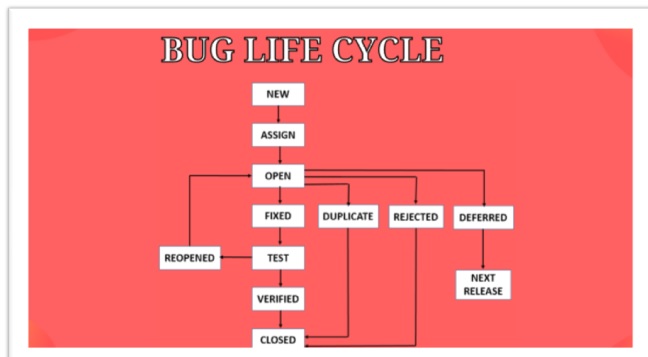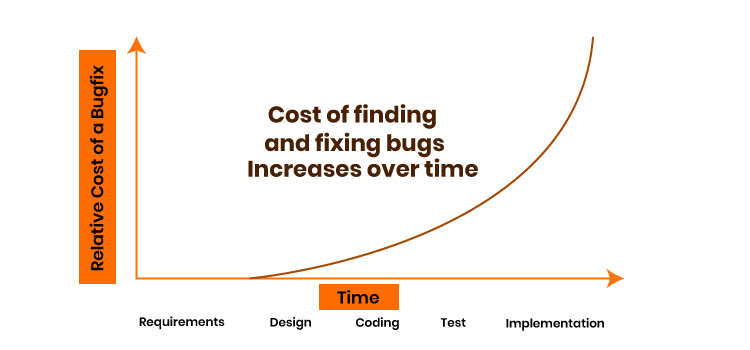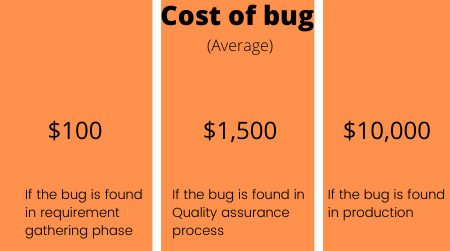
What is a Software Bug? Cost of bug fix!
February 19th, 2020

All applications run on codes in different languages be it Java, .Net, Python, or any other. Most of these codes are written by developers. This also means it is prone to errors. These errors are called Software Bugs. Any deviation from the expected behavior of the application in terms of the functionality, the calculated results, the navigations, or the overall look and feel can be considered as a defect or bug in that application or software.
Bug-free software is every developer’s dream, and it is possible to make this dream a reality only through thorough testing. Different types of techniques are employed to find the maximum number of bugs before the application or product reaches the customers.
What is a software bug?
A software bug can be named as the error or an anomaly in a system that’s causing unusual behavior and invalid output in a system. Errors like these are mostly human-made and can gravely affect the functionality of the software.

What’s bug fixing?
Anomalies that are preventing the software to work as per the SRS document can be fixed through the process called bug fixing. There will be a software testing team to thoroughly examine the software and report the bugs found to developers so that they can fix them.
What are the most common challenges faced in debugging
- Debuggers stop working or there is some issue with it and you are not noticing it
- Logical errors are hard to correct
- unsorted data
- deep log creation issues
- Grammatical errors
- inability to do debugging in realtime
- losing progress in between
What are the different types of software bugs?
There are several different types of bugs that are found in the application. These can be
- Functional Errors
Any issues with the functionality of the application are treated as a functional error. E.g. when you enter some data in the application and hit the “Save” button, your data should be saved to the application database. It should be retrievable at a later stage as well. If the system does not save the data or throws an error while saving, it can be considered a functional defect.
- Logical Errors
A logical error is mainly attributed to the code logic. The logic that was written by the developer may not function as expected leading to incorrect output. A classic example of this would be division by 0 or assigning the value to a wrong variable, or any other such mistake at the coding level. These logical errors can be easily avoided by doing peer reviews and code walk-throughs with the team.
- Calculation Errors
As the name suggests, these bugs arise for the calculation or formulae mistakes at the time of coding. It can also be caused by passing the wrong parameter to the functions. Some other common reasons for a calculation error include choosing the wrong algorithm, mismatch in datatype, incorrect data values flowing from another system, or even hardcoding some values in the code.
- Validation Message Errors
Errors caused by incorrect or missing validation messages are referred to as validation message errors. For example, when entering the wrong data or format, like in a number field (age) you enter characters like name, it should show an appropriate error message. Likewise, whenever you want to save some data, a save confirmation or save failure message should be displayed. In all such cases, both positive and negative message pop-ups or message banners are checked. If they are not displayed, then it is considered an error.
- Cosmetic Errors
Cosmetic errors are those that do not impact the application or its functionality directly. They are also minor issues that are fixed and implemented with the least priority. Some examples of cosmetic errors are spelling mistakes, alignment issues, color variations, and more.
- Work Flow Errors
Workflow errors are also called navigation errors. As the name suggests, they refer to navigation issues when traveling back and forth through the application. The page to be displayed when the “Next” button is clicked or when the “Back” button is clicked, should be as expected. Any mismatch in the expected and actual page is considered a workflow error.
- Integration Errors
Integration error refers to errors arising out of data mismatch or others during the interaction between multiple systems and modules. These errors can be identified only during integration testing. In most cases, these integration errors are caused by how the data from one module is consumed by the other module, or sometimes the data may get altered in the system flow, or there could be a data-type mismatch, etc.
- Memory Leaks
Another common error usually found during rigorous and continuous testing is related to memory leaks. In such cases, the application performance starts deteriorating drastically after a certain period. This is generally due to the continuous use of memory without releasing them after use. Memory leaks are very difficult to find or fix and the only way is to ensure proper coding standards and best practices are followed at the time of coding.
- App Crashes
App Crash is a very priority issue that needs to be resolved at the earliest. It is clear from the name that in such cases the app abruptly closes and all the data is lost. This can be very annoying for the end customers. The crash can be due to several reasons including API call failure, page time out, upstream or downstream system down, or others.
- Security Errors
In the internet world today, security is of utmost importance. Security bugs are very critical. They can be related to the safety of the user data, masking of user data and preferences, financial or health data, security based on privileges ( like admin pages being accessible only to app admins), and more. These issues if found in production can be detrimental to the application itself as the customers would lose trust in the system.

What’s the difference between Bug Priority and Severity
The most common and also the most controversial terms concerning the software bugs are its severity and priority. They are invariably the discussion point between a developer and a tester. Let us try to understand these terms better.
The severity of a bug is the impact that the bug has on the business from a testing point of view.
The priority of the bug on the other hand is fixed by the developers, based on how soon they want to fix the issue and merge with production code.
| Sno | Severity | Priority |
| 1 | It measures the impact of the bug on the business or application | It defines the urgency with which the development team plan to fix the bug |
| 2 | Severity is generally of 4 types: 1. Sev1 – Critical bugs or blockers that do allow the application to be used 2. Sev2 – These are major issues that hamper the functionality of the application. 3. Sev3 – These are minor issues that do not impact the frequently used features in the application 4. Sev4 – These are the least important defects that are cosmetic and do not impact the functionality of the application. Like color, alignment, etc. |
Priority is generally of 4 types: 1. High/Urgent – Need to be fixed immediately. 2. Medium – Can be fixed within the next 1-2 cycles. 3. Low – Very less priority bug. They may or may not be fixed soon based on the team bandwidth 4. Deferred – These bugs are the least priority and are moved to different release at a much later date |
| 3 | Decided by a tester | Decided by a developer |
| 4 | It is related to the quality of the product | It is related to the priority and timeline of the project |
| 5 | It always remains the same | It can change based on business and the available developer bandwidth |
Explaining Bug Life Cycle
Another important term associated with a software bug is the lifecycle. A bug life cycle refers to the different stages a software bug goes through.
The different stages of a bug are:
- New
When a defect or bug is raised by a tester it will be in a new status. Once the developers check, verify, and accept the defect only then it will be moved to the next stage.
- Open/Assigned
Once the developers accept the defect it is moved to the assigned state and is also assigned to a developer for fixing.
- Duplicate
Sometimes a defect raised by the tester would have been raised by someone else previously or a fix for one defect would be applicable for this defect as well, in such cases the developer will mark this new defect as the duplicate of the old one.
- Rejected
Some defects may not be accepted by the developers for various reasons like it may be the expected behavior, it may have already been fixed, or any other reason. These defects are marked as rejected and are not included in any defect metrics.
- Deferred
Some defects may be considered as low priority or they may be fixed with the next module release. These defects are deferred to the next cycle or release
- Fixed
Once the defect is fixed by the developer in the development environment, it is marked as fixed. The code fix for the defect gets moved to the test environment in the next cycle.
- Ready to Test
Once the code fix for the defect is available in the test environment, it is marked as ready to test. Once a new build is available for testing, a tester would ideally filter out the ready to test defects, and do a retest.
- Re-opened
When a tester retest a defect, if the defect is not fixed as expected or if it is only partially fixed, the tester would mark it as re-opened with suitable comments on what needs to be further fixed.
- Verified and closed
During the defect retesting, if the defect is completely fixed, the tester would mark it as verified and closed. This would be the end of the defect cycle for that particular defect.

Why Does Software Have Bugs?
- Coding errors

Programming errors are the most reasonable reason for the bugs in the software. Codes are developed by humans. And as humans, coders are supposed to make mistakes.
There are many bugs that are introduced due to programming errors that might be because of wrong coding of the functionality, syntax errors, etc.
They could even be minor or we can say very clumsy errors that may result in big software flaws. Programming errors can be easily found, but sometimes these tiny errors can be very irritating and time-consuming.
2. Miscommunication

Miscommunication is indeed the reason behind many flaws and misunderstandings in our day-to-day lives. They play no fewer roles in software engineering.
Miscommunication is one of the main reasons behind software defects.
Many a time clients themselves are not clear on their ideas and sometimes even if they are clear of their idea, they are not able to deliver it to the software development and testing team.
This gap in the understanding between the client and the software team is the reason behind many software defects.
Read also: Major bug tracking tools of 2020
- Compex and huge software

Software complexity is another major reason that results in software defects.
It gets even more difficult for developers and testers to have less knowledge of modern software development methods.
The latest software methods can reduce these complexities to a great level, but if the developers are not known to these methods, the software complexities may result in errors.
- Quick deadlines

Deadlines are one of the major reasons for software bugs. Usually, the deadlines in the software industry are comparatively very short.
In order to meet the deadlines, both developers and testers are in a rush to complete the work.
And in this hurry, developers might introduce many programming bugs in the code and the testers might miss out on testing the code properly.
When both developers and testers are responsible for introducing the errors, the code is expected to have a lot many bugs and there are high chances that a buggy code is released to the market.
Software development is not an easy task and this should be properly understood by the clients so that they can give enough amount of time to both developers and testers so that they can receive bug-free software hence saving a lot of time for maintaining and rectifying a buggy software at late hours.
- Frequent changes in requirement

In this dynamic world, everything keeps changing and so does the software requirements.
The constant change in requirements can add problems for the developers and the testers.
Changing requirements are one of the major reasons for software defects.
The frequent requirement changes may confuse and irritate both the developers and testers, hence increasing the chances of faults.
6. Third-party integration

Often development process requires the integration of third-party modules that have been developed entirely different teams. As a stand-alone software, these modules might work fine. However, after integration, their behavior can change and affect the software it has integrated with.
7. automation scripts that have no use

The software industry is very dynamic and every time there is something new that is coming in the market.
The old strategies, codes, scripts soon become obsolete. There are so many obsolete automation scripts that are replaced by more advanced automation scripts.
These obsolete automation scripts if used in the code can mismatch with the new coding techniques and can result in the bugs.
There are many developers and testers who do not keep themselves update with the recent software market techniques and end up using these old automation scripts leading to the introduction of the bugs.
- Poor documentation

Poorly documented code is another reason for software bugs. It is very difficult to maintain and modify such codes. It sometimes leads to losing the flow of the code that results in many errors.
It sometimes even gets harder for the developers to understand their code. In such cases, a requirement change can become even more difficult, leading to more errors.
Such code is given to other coders to rectify or modify, it is very difficult increasing the possibilities of further errors. Though there are no rules for proper documentation of code, it is just considered a good coding practice.
- Software development tools

Visual tools, class libraries, compilers, scripting tools, etc. such development tools can introduce bugs in the software.
Also, it is found that these tools are poorly documents which further adds up to the bugs as we have already discussed above.
No doubt software development tools have made coding comparatively very easy.
Coders are not required to code everything from scratch, readymade scripts, libraries, etc can be easily called in the code, refusing your efforts many forth.
But while they add up to the advantages by providing ready to use stuff, they too add up to the bugs and contribute to poorly documented code.
Cost of fixing bugs

“In 2017, software failures cost the economy US$1.7 trillion in financial losses.”
Software bugs can result in heavy losses and hence as they say “Prevention is better than cure”, it is always better to get these bugs fixed at the early stages of software development lifecycles.
The cost of fixing these bugs grows exponentially with each phase of SDLC. The bugs are easy to detect and rectify at unit testing when the code is still with the developer.
The efforts, time and cost of fixing these bugs keep increasing as the software grows in the lifecycle.
At the development level, it is quite easy to detect and rectify the bugs, as the developer has recently developed the code and it is fresh in his mind.

The most trivial defects can be detected and corrected at this phase, leading to the least software bug fixing cost apprehension.
At the testing phase the complexities of detecting the bugs increases.
Though it is easy to detect functional and other major defects it is another time-consuming task to detect the bug and pass it on to the developer’s team to rectify it.
Also, it is difficult to uncover the more fundamental defects like memory leaks at this stage. Hence the cost of bug fixing increases at this level.
After the release, it is not only very costly to fix the bugs, but is also very risky to release buggy software to end customers. Calling back the software from the market, it is not only a hit to finances but can be very damaging to your reputation also.

Conclusion
The software industry is very dynamic, and it every now and then keeps getting upgraded to a better version of itself to make it more efficient and effective, but bugs are one thing that has always been a part of software codes.
These bugs can sometimes be very easy to locate and rectify but sometimes even the silliest bug can irritate a veteran coder.
Read also: Epic software failures of all time
Hence it both developers and testers should follow software development and testing best practices so that these bugs could be minimized, hence reducing late hours’ efforts to the minimal.
If coding and testing are done with maximum care from the very beginning, we can reduce the number of bugs to a great extent.


 Software Testing Events
Software Testing Events App Testing
App Testing Web App Testing
Web App Testing Game Testing
Game Testing Automation Testing
Automation Testing Load Testing
Load Testing Security Testing
Security Testing Performance Testing
Performance Testing Hire a Tester
Hire a Tester





